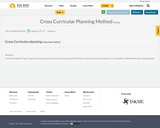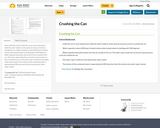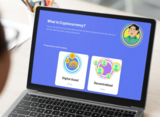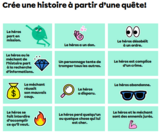
Students understand uses, sustainability, care, and development of crops
- Subject:
- Agriculture Studies
- Material Type:
- Activity/Lab
- Author:
- k-2ag
- Date Added:
- 11/20/2019

Students understand uses, sustainability, care, and development of crops

In our unit on forces and simple machines we incorporated
many different uses of technology. During our unit the students were
given an opportunity to work collaboratively and think critically. After
learning all about simple machine and forces, my class had to
collaboratively design a fair test that would explore one of type of force.
Each group created a fair a test and designed and collected materials to
carry out this experiment. They also had to create a tool to record their
results. During their experiment we had 3 adults with iPads who walked
around the room videoing as the students explained their findings. This
allowed us to check their understanding at this point.
Some ways we used technology throughout this unit
- Used as an instructional tool
- Students used to share their results
- Shared results through pictures and videos
- Present Data
- Generate class discussions
- Final Assessment (students created a PowerPoint)

A brief description of how I organize and plan my cross curricular class for grade 3/4 that is a mix of science, social studies, art, and health. Could be done with any grade level.

This video illustrates how a change in the price of one good affects the quantity demanded of another good (complement or substitute).

In this example, students learn how to read a topographic map and understand map contours. This resource is from PUMAS - Practical Uses of Math and Science - a collection of brief examples created by scientists and engineers showing how math and science topics taught in K-12 classes have real world applications.

Students explore the idea of crossing boundaries through bilingual, spoken-word poetry, culminating in a poetry slam at school or in the community.

Students practice crossing from one family to the next in counting forward with this concentration game.

This tool allows students to complete crossword puzzles on a variety of grade-appropriate topics, and also create and print their own crossword puzzles.

A powerful short documentary exploring Overtourism, featuring interviews with local residents and global experts.
Overtourism occurs when there are too many visitors to a particular destination. When rent prices push out local tenants to make way for holiday rentals, when narrow roads become jammed with tourist vehicles, when tourists cannot view landmarks because of the crowds – these are all signs of overtourism.
And it is the backlash from local residents that has made overtourism news. Cities such as Barcelona, Venice and Dubrovnik, and places once thought of as remote such as Iceland and Skye have suffered firsthand, and the protests by local residents have spread.
There has been decades of virtually uncontrolled growth, and it has crossed a threshold: in many destinations, tourism now demonstrably creates more problems than benefits.

This word problem requires students to create expressions to calculate gas milage for a vehicle.

In which John Green teaches you about the Crusades embarked upon by European Christians in the 12th and 13th centuries. Our traditional perception of the Crusades as European Colonization thinly veiled in religion isn't quite right. John covers the First through the Fourth Crusades, telling you which were successful, which were well-intentioned yet ultimately destructive, and which were just plain crazy. Before you ask, no, he doesn't cover the Children's Crusade, in which children were provoked to gather for a Crusade, and then promptly sold into slavery by the organizers of said Crusade. While this story is charming, it turns out to be complete and utter hooey.

Science Background:
• Inside the can at room temperature (with the water inside) is at the same air pressure as the air outside the can
• Water expands to about 600 times its liquid volume when heated above its boiling point (100 degrees)
• Water expands and pushes almost all of the air outside of the can. The water vapor inside the can has the same pressure as the air outside the can
• Hot water vapor condenses into liquid water when cooled
• The volume of the condensed water is approximately 600 times less than the previous hot water vapor volume

This site offers kids to fun opportunity to crack ciphers, discover secrets, and improve their math skills!

"Crypto Foundations is a digital program that teaches high school students what cryptocurrency is, how it's created on the blockchain, and the risks and benefits of holding cryptocurrencies as an investment. This 101-course provides a reliable source of foundational knowledge as it introduces students to the blockchain world."

Today we’re going to talk about how to keep information secret, and this isn’t a new goal. From as early as Julius Caesar’s Caesar cipher to Mary, Queen of Scots, encrypted messages to kill Queen Elizabeth in 1587, theres has long been a need to encrypt and decrypt private correspondence. This proved especially critical during World War II as Allan Turing and his team at Bletchley Park attempted to decrypt messages from Nazi Enigma machines, and this need has only grown as more and more information sensitive tasks are completed on our computers. So today, we’re going to walk you through some common encryption techniques such as the Advanced Encryption Standard (AES), Diffie-Hellman Key Exchange, and RSA which are employed to keep your information safe, private, and secure.

Developed for third grade. Students observe a crystal growth process.Biology In Elementary Schools is a Saint Michael's College student project. The teaching ideas on this page have been found, refined, and developed by students in a college-level course on the teaching of biology at the elementary level. Unless otherwise noted, the lesson plans have been tried at least once by students from our partner schools. This wiki has been established to share ideas about teaching biology in elementary schools. The motivation behind the creation of this page is twofold: 1. to provide an outlet for the teaching ideas of a group of college educators participating in a workshop-style course; 2. to provide a space where anyone else interested in this topic can place their ideas.

Plan de leçon fourni (mise en situation, tâche d'exploration, discussion, et extension): « En traçant des lignes pour joindre les points d’un ensemble, l’enfant crée des motifs. Ces motifs sont une des stratégies qu’il peut développer pour apprendre à subitizer ... L’idée de subitizer est l’équivalent de la lecture globale des mots en littératie. L’enfant ne décode pas chaque syllabe d’un mot en lecture globale, il reconnaît plutôt le mot d’un seul coup d’œil. La même idée s’applique à la subitisation en mathématique. Subitizer veut dire reconnaître d’un coup d’œil une quantité d’objets. Cela suppose que l’enfant a observé des arrangements familiers de ceux-ci. »

« Les élèves en apprendront davantage sur la création de contenu en ligne et créeront leur propre balado.
-Les élèves en apprendront davantage sur les créateurs et créatrices de contenu et les types de médias qu’ils et elles créent.
-Les élèves planifieront, créeront et monteront un balado.
-Les élèves évalueront les balados des autres élèves et réfléchiront sur leur propre apprentissage. »
Matériel proposé:
-Fiches de lecture (connaissances préalables), de planification, de comparaison (script vs. synopsis), d'évaluation
-Exemples de balados
-Astuces, plans de leçon, questions de discussion, activités supplémentaires

L’angoisse de la page blanche peut frapper tout le monde, même les plus jeunes élèves. Pour les aider à structurer leur récit, n’hésitez pas à utiliser nos idées de quêtes et de péripéties!

An interactive applet and associated web page that demonstrate the properties of a cube. A 3-D cube is shown in the applet which can be interactively manipulated using the mouse. Research has shown that some younger students have difficulty visualizing the parts of a 3D object that are hidden. To help with this, the student can rotate the cube in any axis simply by dragging it with the mouse. It can also be 'exploded' - where a slider gradually separates the faces to reveal the ones behind. The cube can also be made translucent so you see through it to the other side. Applet can be enlarged to full screen size for use with a classroom projector, and printed to make handouts. This resource is a component of the Math Open Reference Interactive Geometry textbook project at http://www.mathopenref.com.